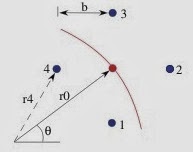The propagation of an action potential is one example of the propagation of a wave in excitable media. We saw in Chap. 7 that waves of depolarization sweep through cardiac tissue. The circulation of a wave of contraction in a ring of cardiac tissue was demonstrated by Mines in 1914. It was first thought that such a wave had to circulate around an anatomic obstacle, but it is now recognized that no obstacle is needed.This year marks the 100th anniversary of Mines’ landmark work. Regis DeSilva, in an article titled “George Ralph Mines, Ventricular Fibrillation and the Discovery of the Vulnerable Period” (Journal of the American College of Cardiology, Volume 29, Pages 1397–1402, 1997) describes Mines’ work in more detail.
George Ralph Mines … made two major contributions to electrophysiology. His scientific legacy includes elucidating the theoretical basis for the occurrence of reentrant arrhythmias and the discovery of the vulnerable period of the ventricle.First, DeSilva discusses Mines’ analysis of reentry in cardiac tissue.
Mines applied his concept of reentry to myocardial tissue and suggested that closed circuits may also exist within heart muscle. Under normal conditions, these circuits are uniformly excited, and an excitatory wave dies out. He suggested that the twin conditions of unidirectional block and slow conduction may occur in abnormal myocardial tissue. Thus, tissue in a reentrant circuit may allow a circulating wavefront to be sustained by virtue of conductive tissue being always available for excitation. In this paper, he also published a now classic figure by illustrating the concept of circus movement in such small myocardial circuits, and this diagram is still used unchanged today in teaching this mechanism to students of electrocardiography (14)Reference 14 (Mines GR, “On Dynamic Equilibrium in the Heart, Journal of Physiology,” Volume 46, Pages 349–383, 1913) is not cited in IPMB.
DeSilva then addresses Mines identification of a “vulnerable period” in the heart.
Mines’ second major contribution was also his most important discovery. It was published … in 1914, entitled “On Circulating Excitations in Heart Muscles and Their Possible Relation to Tachycardia and Fibrillation” [Transactions of the Royal Society of Canada, Volume 8, Pages 43–52, 1914] (15).…[Before 1914] the most common method of inducing fibrillation was by the application of repeated electrical shocks to the heart through an induction coil. Mines’ innovation in studying the onset of fibrillation was to modify the method by applying single shocks to the rabbit heart, and by timing them precisely at various periods during the cardiac cycle.… Stimuli were delivered by single taps of a Morse key, and the moment of application of the stimulus was signaled by the use of a sparking coil connected to an insulated pointer that produced dots on the kymographic trace. Correlation of the position of the dots on the mechanical trace with the electrocardiogram provided an indication of its timing in electrical diastole…. By so doing, ‘it was found in a number of experiments that a single tap of the Morse key if properly timed [his italics] would start fibrillation which would persist for a time. . . . The point of interest is that the stimulus employed would never cause fibrillation unless it was set in at a certain critical instant’ (15)…. The importance of this work lies in the fact that Mines identified for the first time a narrow zone fixed within electrical diastole during which the heart was extremely vulnerable to fibrillation. An external stimulus, or a stimulus generated from within the heart, if properly timed to fall within this zone, could trigger a fatal arrhythmia and cause death. This observation has spurred three generations of scientists to study the factors which cause death by disruption of what Mines called 'the dynamic equilibrium of the heart' (14).Clearly Mines made landmark contributions to our understanding of the heart. But perhaps the most intriguing aspect of Mines’ life was the unusual circumstances of his untimely death. DeSilva writes
On the evening of Saturday November 7, 1914, the night janitor entered Mines’ laboratory and found him lying unconscious with equipment attached, apparently for the recording of respiration (25). He was taken immediately to the Royal Victoria Hospital where he regained consciousness only briefly. Shortly before midnight, he developed seizures and died without regaining consciousness. A complete autopsy was performed, including examination of all the abdominal and thoracic viscera and the brain, but no final diagnosis was rendered (26). The presumption was that death resulted from self-experimentation.Here is how Art Winfree describes the same event, in his Scientific American article “Sudden Cardiac Death: A Problem in Topology”
Mines had been trying to determine whether relatively small, brief electrical stimuli can cause fibrillation. For this work he had constructed a device to deliver electrical impulses to the heart with a magnitude and timing that could be precisely controlled. The device had been employed in preliminary work with animals. When Mines decided it was time to begin work with human beings, he chose the most readily available experimental subject: himself. At about six o’clock that evening a janitor, thinking it was unusually quiet in the laboratory, entered the room. Mines was lying under the laboratory bench surrounded by twisted electrical equipment. A broken mechanism was attached to his chest over the heart and a piece of apparatus nearby was still recording the faltering heartbeat. He died without recovering consciousness.Winfree notes in the 2nd edition of his book The Geometry of Biological Time that there is still some controversy about if Mines' death was truly from self experimentation. The circumstances of his death are certainly suggestive of this, even if we lack definitive proof.
I can't help but notice the similarities between George Ralph Mines and Henry Moseley. Both were Englishmen whose last name started with "M". Both were born at about the same time (Mines in 1886, Moseley in 1887). Both made fundamental contributions to science at an early age (Mines to cardiac electrophysiology, and Moseley to our understanding of the atomic number and the periodic table). Both are probably underappreciated in the history of science, and neither won the Nobel Prize. And both died before reaching the age of 30 (Mines in 1914, Moseley in 1915). Mines died in the mysterious accident in his lab described above, and Moseley died in the Battle of Gallipoli during World War I. And, of course, both are mentioned in the 4th edition of Intermediate Physics for Medicine and Biology.













